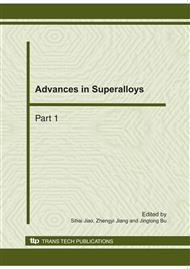[1]
FLUENT6. 1 Manual, Fluent Inc., Lebanon, NH, (2003).
Google Scholar
[2]
Huang X, Thomas B G, Najjar F M. Modeling Superheat Removal During Continuous Casting of Steel Slabs[J]. Met Trains B, 23B(1992), 339.
DOI: 10.1007/bf02656290
Google Scholar
[3]
Hua Bai, Thomas B G. Turbulent Flow of Liquid Steel and Argon Bubbles in Slide Gate Tundish Nozzles: Part I. Model Development and Validation [J]. Metallurgical and Materials Transactions B, 32B(2001), 253.
DOI: 10.1007/s11663-001-0049-z
Google Scholar
[4]
Brian G. THOMAS, Lifeng ZHANG. Mathematical Modeling of Fluid Flow in Continuous Casting. ISIJ international, 41(2001), No. 10, 1181.
DOI: 10.2355/isijinternational.41.1181
Google Scholar
[5]
Cuina WANG, Liangying WEN and Dengfu CHEN etc. Numerical Simulation on Flow Field in Mold for Slab Casting[J], Chinese Journal of Process Engineering, China, 9(2009), suppl. No. 1, 325 ( In Chinese ).
Google Scholar
[6]
Cuina WANG, Liangying WEN and Dengfu CHEN etc. Effect of Bottom Structure of Submerged Entry Nozzle on Flow Field and Temperature Field in continuous casting mold. Iron and Steel, China, 45(2010), No. 1, 37 (In Chinese ).
Google Scholar
[7]
Nguyen A V, Evans G M. Computational Fluid Dynamics Modeling of Gas Jets impinging Onto Liquid Pools[J]. Applied mathematical modeling, 30(2006), 1472.
DOI: 10.1016/j.apm.2006.03.015
Google Scholar
[8]
Hailun XU, Guanghua WEN, Ping TANG etc. Numerical simulation of asymmetry flow phenomena in a mold for slab continuous casting[J]. Journal of University of Science and Technology Beijing, Vol. 31 No. 6 Jun. 2009 ( In Chinese ).
Google Scholar
[9]
Niangen XIAO, Shengqi NI, Huijie FU. Numerical Simulation of Comprehensive Metallurgical Behavior of Liquid Steel in Slab Mold[J]. IRON STEEL VANADIUM TITANIUM, Vol. 30, No. 3 July 2009 ( In Chinese ).
Google Scholar
[10]
R. Chaudhary, B.T. Rietow, B.G. Thomas. Differences between Physical Water Models and Steel Continuous Casters: A Theoretical Evaluation[J]. Materials Science and Technology (MS&T) (2009).
Google Scholar
[11]
LIB K. Study on Turbulent flow field of liquid steel and its electromagnetic control in continuous casting mold at high casting speed. Iron Steel, 2005 , 40 (7) : 33.
Google Scholar
[12]
M Y Zhu, J Q Liu, Z Q Xiao. Simulation of molten steel flow in slab continuous casting mold. Iron Steel, 1996, 31 (8) : 23 ( In Chinese ).
Google Scholar
[13]
Kaike CAI: The Continuous Casting Mold, China Metallurgical Industry Press, China, (2008) ( In Chinese ).
Google Scholar
[14]
Bingjian Yian, Junyi Su, Xiahua Zhu. Numerical Simulation on the Solidified Shell Thickness in Continuous Casting Mold and Experimental Verification. Journal of Xi'an Jiaotong University, 31(1997), No. 10, 72 ( In Chinese ).
Google Scholar


